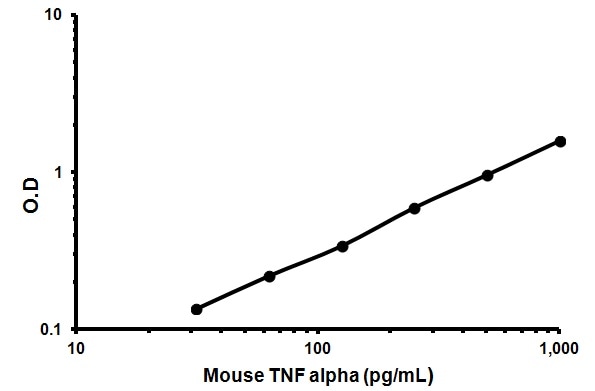Mouse TNF alpha ELISA Kit (ab46105)
Key features and details
- Sensitivity: 25 pg/ml
- Range: 31.25 pg/ml - 1000 pg/ml
- Sample type: Cell culture supernatant, Plasma, Serum
- Detection method: Colorimetric
- Assay type: Sandwich (quantitative)
- Reacts with: Mouse
Properties
-
Storage instructions
Store at +4°C. Please refer to protocols. -
Components Identifier 1 x 96 tests 2 x 96 tests 10X Standard Diluent Buffer Black 1 x 25ml 1 x 25ml 200X Wash Buffer White 1 x 10ml 2 x 10ml Biotinylated Antibody Diluent Red 1 x 7.5ml 1 x 13ml Biotinylated anti-TNFalpha Red 1 x 400µl 2 x 400µl Chromogen TMB Substrate Solution 1 x 11ml 1 x 24ml HRP Diluent Red 1 x 23ml 1 x 23ml Plastic Plate Covers 1 x 2 units 2 x 2 units Stop Reagent Black 1 x 11ml 2 x 11ml Streptavidin-HRP 2 x 5µl 4 x 5µl TNF alpha Microplate (12 x 8 well strips) 1 unit 2 units TNF alpha Standard (lyophilized) Yellow 2 vials 4 vials -
Research areas
-
Function
Cytokine that binds to TNFRSF1A/TNFR1 and TNFRSF1B/TNFBR. It is mainly secreted by macrophages and can induce cell death of certain tumor cell lines. It is potent pyrogen causing fever by direct action or by stimulation of interleukin-1 secretion and is implicated in the induction of cachexia, Under certain conditions it can stimulate cell proliferation and induce cell differentiation. -
Involvement in disease
Genetic variations in TNF are a cause of susceptibility psoriatic arthritis (PSORAS) [MIM:607507]. PSORAS is an inflammatory, seronegative arthritis associated with psoriasis. It is a heterogeneous disorder ranging from a mild, non-destructive disease to a severe, progressive, erosive arthropathy. Five types of psoriatic arthritis have been defined: asymmetrical oligoarthritis characterized by primary involvement of the small joints of the fingers or toes; asymmetrical arthritis which involves the joints of the extremities; symmetrical polyarthritis characterized by a rheumatoidlike pattern that can involve hands, wrists, ankles, and feet; arthritis mutilans, which is a rare but deforming and destructive condition; arthritis of the sacroiliac joints and spine (psoriatic spondylitis). -
Sequence similarities
Belongs to the tumor necrosis factor family. -
Post-translational
modificationsThe soluble form derives from the membrane form by proteolytic processing.
The membrane form, but not the soluble form, is phosphorylated on serine residues. Dephosphorylation of the membrane form occurs by binding to soluble TNFRSF1A/TNFR1.
O-glycosylated; glycans contain galactose, N-acetylgalactosamine and N-acetylneuraminic acid. -
Cellular localization
Secreted and Cell membrane. - Information by UniProt
-
Alternative names
- APC1
- APC1 protein
- Cachectin
see all -
Database links
- Entrez Gene: 21926 Mouse
- SwissProt: P06804 Mouse
- Unigene: 1293 Mouse













